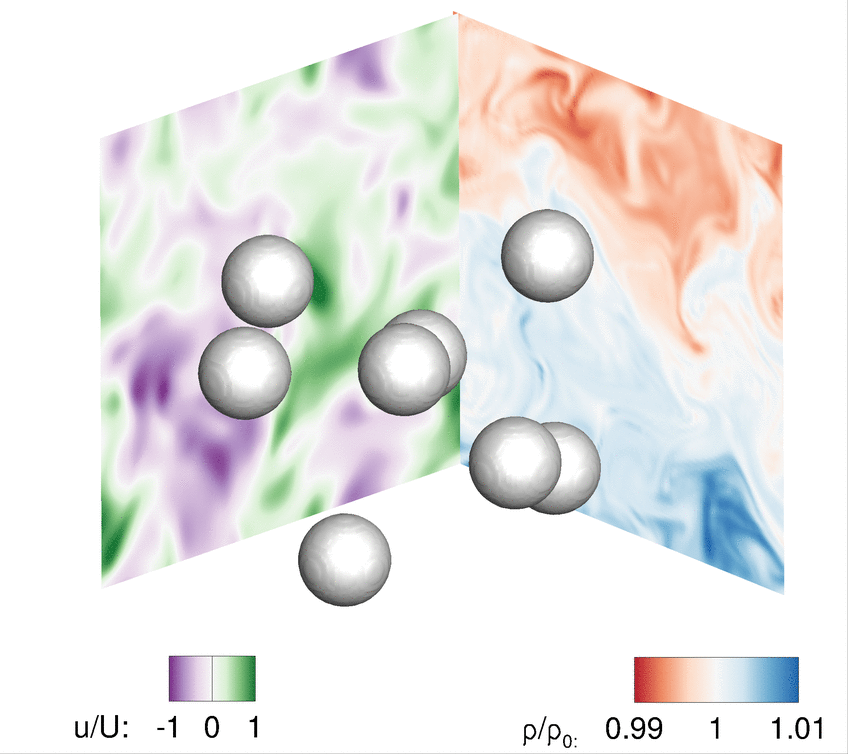January 14, 2016
Hotspots of small swimming marine organisms may contribute to mixing
 |
|
New research using high-fidelity numerical simulations is revealing details about how “hotspots” of small swimming organisms might contribute to the mixing of ocean waters. The research is depicted in this animated GIF. (Purdue University image/Shiyan Wang and Arezoo Ardekani) |
WEST LAFAYETTE, Ind. – New research findings suggest small marine organisms swimming in concentrated "hotspots" likely contribute to the mixing of water needed to distribute nutrients for ocean species.
The ocean consists of a top nutrient-depleted layer that is well mixed by turbulence created primarily by wind, tides and other mechanisms, and a bottom unmixed nutrient-rich layer. In between is a layer called the pycnocline marked by a sharp change in density, said Arezoo Ardekani, an assistant professor of mechanical engineering at Purdue University.
"We are trying to learn about the potential contribution of marine organisms to the mixing processes that transport water from this nutrient-rich bottom region through the pycnoline layer and to the nutrient-depleted region," she said.
Ocean mixing is critical for distributing nutrients to the nutrient-depleted layer.
"Some marine organisms move vertically between the top and bottom layers during the day and night through a process called diel vertical migration," she said.
While it is known that wind and waves are the primary cause of ocean mixing, one unknown factor is whether swimming organisms contribute to this vital mixing. Previous research has suggested the organisms transport volumes of fluid and nutrients with them, a concept known as Darwinian drift. However, some scientists argue that the drifted fluid can re-stratify in marine environments and may not cause mixing.
The Purdue researchers used high-fidelity numerical simulation (animated gif available) of a "simplified swimming model" to determine whether the small ocean organisms such as zooplankton swimming in concentrated hotspots contribute to the mixing.
"So there are local hotspots where this mixing can be comparable to the turbulent mixing in the mid-ocean," Ardekani said. "The mixing induced by horizontally swimming organisms is one hundred times weaker than the contribution of vertically swimming organisms."
The hotspots may be especially important in the mid-ocean, where the majority of energy from waves and wind is dissipated prior to contributing to mixing.
Findings were detailed in a paper published in December in the journal Scientific Reports published by the Nature Publishing Group. The paper was authored by doctoral student Shiyan Wang and Ardekani.
The research was carried out with high-performance computing clusters operated by Information Technology at Purdue and also the Center for Research Computing at the University of Notre Dame.
The work was supported in part by the National Science Foundation.
Writer: Emil Venere, 765-494-4709, venere@purdue.edu
Source: Arezoo Ardekani, ardekani@purdue.edu
Note to Journalists: A copy of the research paper is available from Emil Venere, Purdue News Service, 765-494-4709, venere@purdue.edu.
ABSTRACT
Biogenic mixing induced by intermediate Reynolds number swimming in a stratified fluid
Shiyan Wang1,2,* and Arezoo M. Ardekani1,2,*
1School of Mechanical Engineering, Purdue University
We study fully resolved motion of interacting swimmers in density stratified fluids using an archetypal swimming model called "squirmer." The intermediate Reynolds number regime is particularly important, because the vast majority of organisms in the aphotic ocean (i.e. regions that are 200 m beneath the sea surface) are small (mm-cm) and their motion is governed by the balance of inertial and viscous forces. Our study shows that the mixing efficiency and the diapycnal eddy diffusivity, a measure of vertical mass flux, within a suspension of squirmers increases with Reynolds number. The mixing efficiency is in the range of O(0.0001–0.04) when the swimming Reynolds number is in the range of O(0.1–100). The values of diapycnal eddy diffusivity and Cox number are two orders of magnitude larger for vertically swimming cells compared to horizontally swimming cells. For a suspension of squirmers in a decaying isotropic turbulence, we find that the diapycnal eddy diffusivity enhances due to the strong viscous dissipation generated by squirmers as well as the interaction of squirmers with the background turbulence.

